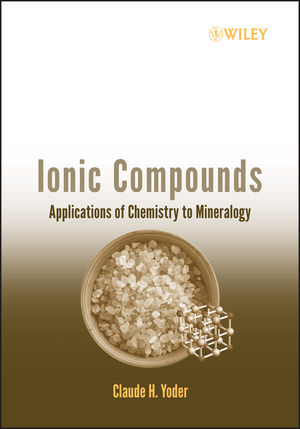Ionic Compounds: Applications of Chemistry to MineralogyISBN: 978-0-471-74046-9
Paperback
216 pages
October 2006
 This is a Print-on-Demand title. It will be printed specifically to fill your order. Please allow an additional 10-15 days delivery time. The book is not returnable.
|
||||||
Preface vii
1. Bonding and Composition 1
1.1 Types of Bonding 3
1.2 Ionic Compounds 5
1.2.1 Types of Ions 5
1.2.2 Names of Ions 8
1.3 Percent Composition and Empirical Formula 11
1.3.1 The Mole 13
Molar Mass (Formula Weight) 15
1.3.2 Calculation of Empirical Formula from Percent Composition 15
1.3.3 Use of Oxide Data 17
1.3.4 Formulas for Solid Solutions 18
1.4 Covalent Character in Ionic Compounds 19
1.5 Interactions Between Ions 22
1.5.1 Some Laws of Electrostatics 22
Potential Energy of Charged Particles 23
1.5.2 Lattice Energy and Its Effect on Properties 27
2. The Structure of Ionic Compounds: Closest Packing 29
2.1 Closest Packing of Ions 30
2.1.1 The Holes Between the Layers 31
2.1.2 Stacking Sequences 33
2.1.3 Closest Packing for Ionic Compounds 36
2.1.4 Relationship of Formula to Occupation of Voids 39
3. The Symmetry of Crystals 41
3.1 Symmetry Elements 41
3.2 Hermann-Mauguin Notation (Point Groups) 49
3.3 Crystal Systems 53
3.3.1 Crystallographic Axes 54
4. The Structure of Some Simple Closest-packed Compounds 59
4.1 Symmetry of the AB and ABC Closest-packed Arrangements 59
4.2 The Unit Cell 60
4.3 The NaCl Structure 65
4.4 The Sphalerite Structure 68
4.5 Axial Relationships 72
4.6 Wurtzite, a Polymorph of Sphalerite 74
4.7 The Fluorite Structure 76
4.8 The Rutile Structure, Polyhedral Coordination Models 80
5. Factors that Affect the Symmetry of the Unit Cell 87
5.1 Effect of Cation 87
5.1.1 The Chalcopyrite Structure and Solid Solution 88
5.2 Effect of the Anion 90
5.2.1 Some Oxy Anions 90
5.2.2 The Pyrite Structure 92
5.2.3 The Calcite Structure 95
5.2.4 Aragonite, A Polymorph of Calcite 97
5.2.5 Several Sulfates, Anhydrite and Barite 100
5.2.6 Several Silicates, Zircon, and Beryl 106
The Silicates 108
5.3 Effect of Temperature and Pressure 113
6. Physical Properties: Morphology 115
6.1 Crystal Morphology 115
6.2 Miller Indices 115
6.3 Forms 118
6.3.1 Habit 127
6.4 Deviations in Crystal Growth 129
6.4.1 Parallel Growth 129
6.4.2 Twinning 129
6.4.3 Epitaxis and Pseudomorphism 131
7. Physical Properties: Color 135
7.1 Light and the Electromagnetic Spectrum 135
7.2 The Nature of Electrons 136
7.3 Electron Configurations 142
7.4 The Crystal Field Model 143
7.5 Colored Cations 147
7.6 Ion Impurities 148
7.7 Crystal Defects 148
8. Chemical Properties 149
8.1 Solubility 149
8.1.1 Energetics of Dissolution 151
8.1.2 Solubility Rules 155
8.1.3 Double Salts 156
8.2 Reaction with Acids 157
8.2.1 Types of Chemical Reactions 157
8.2.2 Water as Both Acid and Base 159
8.2.3 Strong and Weak Acids 160
8.2.4 Conjugate Bases 160
8.3 Use of Chemical Reactions for Identification 162
Appendices 165
1. The Periodic Chart 165
2. The Elements: Symbols, Melting Points, Boiling Points, Densities, and Electronegativities 169
3. Metallic, Covalent, and Ionic Radii 171
4. Quartz 173
5. Crystal System Identification Practice 177
6. Crystal Systems and Classes 179
7. Additional Reading and Resources 181
Index 183



